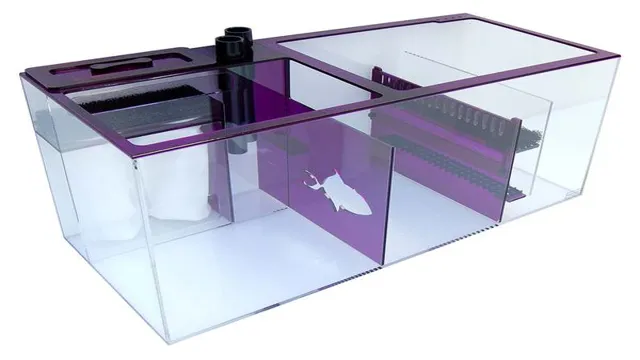Aquarium LED lights are a popular choice for fish enthusiasts due to their energy efficiency and aesthetic appeal. However, sometimes the brightness of these lights can be overwhelming for both the fish and their owners. So, how do you dim aquarium LED lights? In this comprehensive guide, we will explore different methods for adjusting the brightness of your aquarium lights to create a more comfortable environment for your fish and enhance the overall ambiance of your tank.
From using dimming switches to adjusting color temperatures, we’ve got you covered. So, let’s dive in and learn how to create the perfect lighting for your aquatic friends.
Understanding Your Aquarium LED Lights
As a aquarium owner, it is important to understand how to control the brightness of your LED lights to create a pleasant environment for your aquatic pets. One way to do so is by dimming the aquarium LED lights. Most aquarium LED lights come with a dimming feature that allows you to adjust the intensity of the light.
By reducing the brightness of your aquarium LED lights, you can create a natural-looking environment for your fish and plants. Dimming the lights can also help reduce algae growth and the risk of overheating the tank water. To dim your aquarium LED lights, check the user manual of your light fixture for specific instructions.
Generally, you can adjust the brightness using the controller or remote provided with the lights. By following these steps, you can create a comfortable environment for your aquarium inhabitants using your aquarium LED lights.
Types of LED Lights
When it comes to aquarium LED lights, it’s important to understand the different types available and what they offer. One common type of LED light is the white light, which provides a bright, natural-looking illumination that mimics sunlight. This can be great for showcasing vibrant fish and corals.
Another popular type is the blue light, which is favored by many marine aquarists because it promotes healthy coral growth and enhances fluorescent colors. Some LED lights even offer a combination of both white and blue, allowing aquarists to customize the lighting to their preferences. By understanding the different types of LED lights available for aquariums, you can choose the best one for your needs and create a beautiful, healthy environment for your aquatic pets to call home.

Factors That Affect Brightness
Aquarium LED lights have become an essential tool for hobbyists and professionals alike when it comes to creating the perfect aquatic environment for their fishes and aquatic plants. One of the most critical factors that you should consider when getting aquarium LED lights is the brightness. The brightness of the light is controlled by an array of factors such as bulb wattage, lumens output, light spectrum distribution, and bulb placement.
Wattage determines the energy usage of the bulbs and consequently the brightness they emit. Lumens output, on the other hand, refers to the light’s brightness and efficiency. Lastly, bulb placement directly affects the area coverage of the light.
To get the perfect brightness for your aquarium, make sure you have the right bulb wattage, check the lumens output, and strategically place the bulbs according to your tank’s area. Overall, understanding your aquarium LED lights is essential in creating and maintaining a healthy aquatic environment for your aquatic pets.
Methods to Dim Aquarium LED Lights
If you are dealing with overly bright LED lights in your aquarium, don’t worry, there are several methods to dim them down to a more suitable level. One of the most common solutions is to use a light dimmer switch, which can effectively regulate the brightness of your aquarium LED lights. Another method is to use colored films or gels to tone down the intensity of the light.
These can be placed onto the aquarium glass or directly onto the light itself. Alternatively, you can try adjusting the distance between the LED lights and the surface of your aquarium water, as this can have a significant effect on the brightness of the tank. Lastly, if all else fails, you may need to replace your current LED lights with a more suitable and less powerful option.
Overall, finding the right balance of light intensity and duration is crucial for a healthy and thriving aquarium ecosystem.
1. Using a Dimmer Switch
Dimming aquarium LED lights is an important consideration for hobbyists who want to create optimal lighting conditions for their aquatic pets. One popular method to dim aquarium LED lights is by using a dimmer switch. A dimmer switch allows you to control the brightness of your aquarium lights by adjusting the voltage provided to the LEDs.
Dimmer switches are available in a variety of types and sizes, so it’s important to select one that is appropriate for your aquarium and LED lighting system. By using a dimmer switch, you can mimic natural lighting conditions for your fish and other aquatic creatures, which can help promote their overall health and well-being. Plus, dimming your aquarium lights can create a more calming and relaxing environment for both you and your pets.
Overall, using a dimmer switch is a simple and effective way to adjust the brightness of your aquarium LED lights and create the perfect lighting conditions for your aquatic pets.
2. Using a Timer
If you want to dim your aquarium LED lights, using a timer is one of the simplest and most effective methods. By setting a specific time for your LEDs to turn on and off, you can ensure a consistent cycle of light and darkness for your aquarium inhabitants. This method is also beneficial for replicating the natural photoperiod of your fish and plants. (See Also: How to Care for Water Lettuce in Aquarium: Tips for Ensuring Optimal Growth and Health)
By establishing a regular lighting schedule, you can reduce stress on your aquatic inhabitants and promote healthy growth. Additionally, using a timer can help you save energy and money by minimizing the amount of time your lights are on. Overall, using a timer is a straightforward and convenient way to dim your aquarium LED lights and maintain a healthy environment for your aquatic pets.
3. Using Light Hoods with Built-in Dimming Functions
One effective method of dimming LED aquarium lights is by using light hoods that have built-in dimming functions. These hoods are specifically designed to fit aquariums and come in a variety of sizes to match different tank dimensions. With their built-in dimming features, you can easily adjust the brightness level of your LED lights to create the perfect environment for your fish and plants.
You can easily customize the lighting depending on the time of day or your personal preferences, making it easier to maintain a healthy ecosystem inside your aquarium. These light hoods are user-friendly and typically come with intuitive controls, so even beginners can adjust the brightness with ease. Overall, using light hoods with built-in dimming functions is a great way to take full control of your aquarium lighting and ensure that your aquatic life thrives.
How to Install a Dimmer Switch
If you have bright LED lights in your aquarium and find them a little overwhelming, installing a dimmer switch can help create a more relaxing atmosphere for your fish. As with any electrical project, always turn off the power at the circuit breaker before starting. Begin by removing the existing light switch cover and disconnecting the wires.
Follow the manufacturer’s instructions to connect the wires to the dimmer switch. Once the switch is securely attached, turn the power back on to test it. Adjust the dimmer switch to your desired level of brightness, and you’re all set.
With a dimmer switch, you can create the perfect ambiance for your aquatic pets while still enjoying the benefits of LED lighting.
Step One: Choose the Right Dimmer Switch
Installing a dimmer switch can be a great way to improve the ambiance of your home. But, before you begin installing, it’s essential to choose the right dimmer switch. Not all switches are made equal, and making the right choice can significantly impact the functionality and lifespan of your lights.
The first thing you need to consider is the type of bulb you’re using. Different bulbs have different wattage limits, and you need to ensure that the dimmer switch you select can handle the maximum wattage of your bulbs. Look for switches that are compatible with LED, CFL, and incandescent bulbs.
Additionally, look for a switch that can operate multiple fixtures or fans and that is easy to install, ultimately reducing any risk of damage to the switch itself. By carefully selecting the right dimmer switch, the functionality of your lights will be enhanced, and you’ll be well on your way to an improved home atmosphere.
Step Two: Turn Off the Power
When it comes to installing a dimmer switch, safety should be your top priority. The first step in ensuring your safety is to turn off the power to the room you’ll be working in. This may seem like an obvious step, but it’s worth repeating because it’s so important.
To turn off the power, locate your home’s circuit breaker box and flip the switch that corresponds to the room where you’ll be installing the dimmer switch. If you’re not sure which switch to flip, turn off the main circuit breaker for your entire home to be safe. It’s critical that you follow this step before beginning to work on your electrical project, as electricity can be extremely dangerous and even deadly.
By turning off the power, you’ll reduce the risk of electrocution and ensure that you can safely install your new dimmer switch. Remember to double-check that the power is off before continuing with the installation.
Step Three: Remove the Switch Cover Plate
Now that you’ve turned off the power supply, it’s time to get the switch cover plate off. You can do this by removing the screws that fasten it to the wall. Depending on how secure the plate is, you may need to use a flat-head screwdriver to pry it loose gently.
Make sure not to damage the plate or the wall in the process. Once the cover plate is loose, set it aside and use your voltage tester again to confirm that there’s no power running through the wires. This is a crucial step as it ensures your safety while working on the switch.
With the power off, you can proceed with the installation of the dimmer switch. Just remember to be careful when handling the wires, and make sure that everything is properly connected before securing the switch into place. With these precautions, you’ll be well on your way to upgrading your home’s lighting system.
Step Four: Remove Existing Switch
As we move on to the fourth step of installing a dimmer switch, you need to remove the old or existing switch. To do this, you must first turn off the power supply to the switch from the main circuit breaker. After that, you need to remove the switch cover plate using a screwdriver. (See Also: How to Make Homemade Fertilizer for Aquarium Plants: Easy and Effective Formulas!)
Once you have access to the switch, loosen the screws connecting the switch to the wall and gently pull out the switch. Make sure to note the wires’ positions and connections. You may want to take photos or label the wires to avoid confusion when you install the dimmer switch.
It is essential to remove the old switch before installing the new dimmer switch to prevent any accidents or malfunctions. Remember to handle the wires carefully to avoid damaging them or the switch terminals. With the existing switch removed, you’re now ready to proceed with installing the dimmer switch for an improved lighting experience.
Step Five: Connect the New Dimmer Switch
Once you’ve connected the wires as outlined in the previous step, it’s time to connect the new dimmer switch. This is a simple process but can vary depending on the type of switch you have. Make sure to refer to the manufacturer’s instructions for your specific switch.
Generally, you will want to align the switch’s wires with the wires in the electrical box. Connect the hot wire to the black or red wire from the switch. The ground wire should be connected to the green or bare wire from the switch.
Lastly, connect the neutral wire to the white wire from the switch. Once all wires are securely connected, carefully tuck them back into the electrical box and attach the new dimmer switch to the box with the provided screws. Make sure the switch is level and straight before tightening completely.
Now, it’s time to test the switch to make sure it’s working properly. Turn on the power and test the switch by adjusting it from low to high. Congratulations, you have successfully installed a dimmer switch!
Step Six: Attach the Cover Plate
To complete your dimmer switch installation, the final step is to attach the cover plate. This might seem like a small detail, but it is important for safety and aesthetics. Start by aligning the cover plate with the switch and using the screws provided to secure it in place.
Be sure to tighten the screws evenly to avoid any gaps or wobbling. Once the cover plate is attached, turn the power back on and test the switch to ensure that it is working properly. Overall, the process of installing a dimmer switch can seem daunting at first, but it is actually quite simple.
With the right tools and a bit of patience, you can give any room in your home a new level of ambiance and control. So why not try it out? Your eyes (and wallet) will thank you for the energy savings, and your guests will admire the stylish upgrade.
Tips for Dimming Your Aquarium LED Lights
If you have bright LED lights in your aquarium, dimming them can be a great way to enhance the environment for your aquatic pets. Here are some tips on how to dim your aquarium LED lights. Firstly, ensure that the LED lights you choose are indeed dimmable.
Make sure you have a compatible dimming device in place by checking the product specifications and downloading the user manual from the manufacturer’s website. Next, calibrate your dimming device by setting up the software and adjusting settings. You will typically have options to adjust the intensity and duration of the light.
Slowly decrease the brightness of the LEDs until you reach the desired level. It’s crucial to remember that dimming the lights too quickly can be harmful to the fish, as sudden light changes can cause stress. Overall, by dimming your aquarium LED lights, you can improve the well-being of your fish and create a more comfortable environment for them.
Avoid Over-Dimming
As an aquarium owner, you may be tempted to dim your LED lights for aesthetic purposes or to simulate a natural day-night cycle for your aquatic creatures. However, it’s important to avoid over-dimming your lights as it can lead to issues with plant growth and nutrient uptake. Instead, consider using a light timer to regulate the amount of light your tank receives per day and aim for consistent lighting levels to promote healthy growth.
Additionally, pay attention to the specific lighting requirements of your fish and plants and adjust your lighting accordingly. By taking small steps to properly dim your aquarium LED lights, you can create a beautiful and healthy environment for your aquatic pets to thrive in.
Monitor Your Fish and Plants
If you’re an aquarium enthusiast, you know how important it is to monitor your fish and plants to ensure they’re healthy and thriving. One aspect of this monitoring is dimming your aquarium LED lights. While LED lights provide bright and energy-efficient lighting for your tank, they can also be too intense and cause stress and harm to your aquatic creatures and plants.
To prevent this, consider implementing a lighting schedule and gradually dimming the lights during the night time hours. This will mimic natural light patterns and allow your fish to rest and recharge. Additionally, using a timer can make this process much easier. (See Also: How to Beat Lava Rock in Half for Aquarium: A Step-by-Step Guide)
By following these tips and monitoring your aquarium, you can create a healthy and stress-free environment for your aquatic friends to call home.
Use the Right Lighting Schedule
Dimming your aquarium LED lights can be beneficial for the health of your aquatic pets. One essential tip for dimming is to use the right lighting schedule. Creating a proper, consistent schedule helps mimic the natural lighting conditions of your fish’s habitat, which can improve their behavior and overall well-being.
It’s crucial to remember that aquatic creatures rely heavily on the presence and absence of light to regulate their daily lives. Therefore, having a smart schedule that creates appropriate lighting conditions helps maintain your aquatic pets’ physiological and psychological balance. By following this practice, your fishes will have consistent access to light, which can significantly influence their feeding, mating, and sleeping patterns.
So, if you want to keep your aquarium-dwelling pets healthy and happy, pay attention to the light fluctuation in their environment and implement a suitable dimming schedule based on their needs.
Conclusion
In conclusion, dimming your aquarium’s bright LED lights doesn’t have to be a daunting task. By following these simple steps, you’ll be able to provide a cozy and comfortable environment for your aquatic pals without sacrificing style and ambiance. Think of it as giving your aquarium a relaxing spa day – a little dimming can go a long way in creating a serene and soothing atmosphere.
So go ahead, dim those lights and let the good vibes flow!”
FAQs
What are the benefits of dimming aquarium LED lights?
Dimming aquarium LED lights can help replicate natural lighting conditions, reduce stress on fish and plants, and provide energy savings.
Can all LED aquarium lights be dimmed?
No, not all LED aquarium lights can be dimmed. It’s essential to check the product manual or specifications before making a purchase.
How do you dim LED aquarium lights?
Most LED aquarium lights can be dimmed using either a controller, remote, or smartphone app. Refer to the product manual for specific instructions.
Is it safe to dim LED aquarium lights?
Yes, it’s safe to dim LED aquarium lights as long as you follow the manufacturer’s instructions and don’t exceed the maximum dimming capabilities.
Can dimming LED aquarium lights extend its lifespan?
Yes, dimming LED aquarium lights can help reduce the heat produced, which can, in turn, extend the lifespan of the lights.
How to figure out the appropriate light intensity to dim aquarium LED lights?
Check the product manual or research the lighting requirements for your specific plants or fish species to determine the optimum light intensity for dimming.
Are there any downsides to dimming aquarium LED lights?
The only potential downside is if you dim the lights too much, your plants may not receive adequate light for photosynthesis, affecting their growth.







